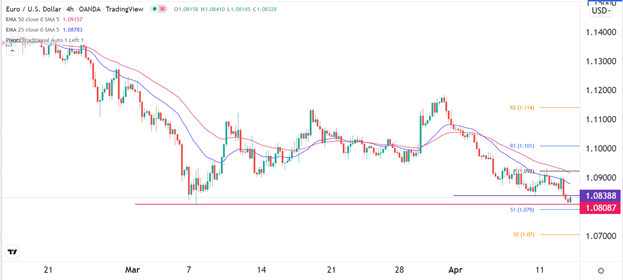Bearish View
- Sell the EUR/USD pair and set a take-profit at 1.0700.
- Add a stop-loss at 1.0925.
- Timeline: 1-2 days.
Bullish View
- Set a buy-stop at 1.0860 and a take-profit at 1.0950.
- Add a stop-loss at 1.0750.
The EUR/USD pair declined sharply on Tuesday and on Wednesday morning as investors reacted to the latest US inflation data. It is trading at 1.0835, which was sharply lower than the highest level this week. Focus now shifts to the upcoming interest rate decision by the European Central Bank (ECB).
US Inflation Data
The EUR/USD pair declined even after the stronger-than-expected US inflation data. According to the US government, the rising cost of energy pushed the prices of most items sharply in March. On a year-on-year basis, the CPI rose to 8.5%, the highest it has been since the 1980s. Excluding the volatile food and energy prices, the CPI rose from 6.4% to 6.5%.
However, digging deeper into the data showed that core inflation actually declined on a month-on-month basis. It moved from 0.5% in February to 0.3% in March. It was lower than the median estimate of 0.5% and was the lowest level since August last year. Therefore, there is a likelihood that prices will stabilize if oil and gas prices retreat.
US stocks rebounded sharply after the strong US inflation numbers, with the Dow Jones and Nasdaq 100 indices rising by more than 1%. They then quickly erased those gains and ended in the red.On the other hand, bond yields that have been in a strong bullish trend retreated after the inflation numbers. The 10-year is trading at 2.6% while the 2-year is trading at 2.3%.
The next catalyst for the EUR/USD will be the latest producer price index (PPI) data that will come out on Wednesday. Economists expect that the headline PPI rose from 10.0% in February to 10.6% in March while the core PPI rose to 8.4%.
Investors will also be anticipating for the upcoming interest rate decision by the European Central Bank scheduled for Thursday.
EUR/USD Forecast
The EUR/USD pair declined after the strong US inflation data. On the four-hour chart, the pair remains below the 25-day moving average. It also moved below the standard pivot point and is now approaching the first support of this level. The pair is also approaching the important support at 1.0800, which was the lowest level on March 7th.
Therefore, the pair will likely keep falling ahead of the upcoming interest rate decision by the ECB. If this happens, the next key support will be at 1.0700.


